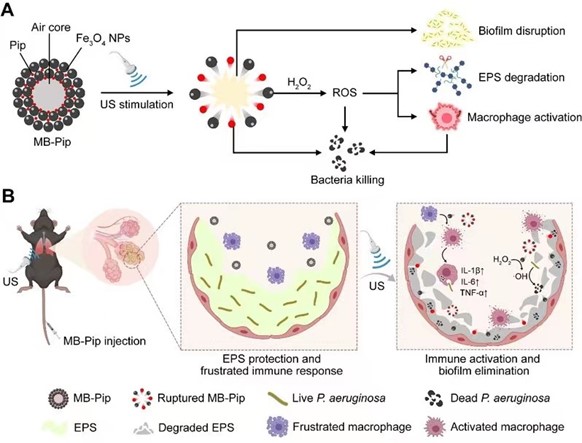Recently, Nanjing University of Posts and Telecommunications Institute of Information Materials and Nanotechnology, State Key Laboratory of Organic Electronics and Information Display, Professor Wang Lianhui, Associate Professor Yuwen Lihui and Associate Professor Gao Yu developed ultrasonic-response catalytic microbubbles for the treatment of chronic lung infections caused by Pseudomonas aeruginosa. The related achievements were recently published in Science Advances, the top international academic journal, with the title of Ultra-responsive Catalytic Microbubbles Enhance Biofilm Elimination and Immune Activation to Treat Chronic Lung Infections, and were selected as the Featured Image of the current magazine. Associate professors Yuwen Lihui, Gao Yu and Professor Wang Lianhui from the College of Materials Science and Engineering are co-authors, and doctoral student Xiu Weijun is the first author of the paper.
Paeruginosa prevents drug penetration and immune cell phagocytosis by forming biofilm, and secretes toxic factors to inhibit the immune response of the host, leading to antibiotic tolerance and immune escape. Therefore, chronic pneumonia is difficult to be eliminated by traditional antibiotics. It is of great significance to develop new biofilm therapeutic reagents for Pseudomonas aeruginosa.
The team constructed ultrasonic response drug-loaded catalytic microbubbles (MB-Pip) composed of Fe3O4 nanoparticles (Fe3O4 NPs) and piperacillin (Pip) for the removal of Pseudomonas aeruginosa biofilm. Under the action of ultrasound, MB-Pip generates inertial cavitation, which disrupts the biofilm structure through mechanical effect. The released Fe3O4 NPs can catalyze the degradation of extracellular matrix, realize the physical/chemical dual-mode biofilm destruction, and effectively enhance the drug penetration and antibacterial performance. In addition, Fe3O4 NPs can activate macrophages to polarize to M1 phenotype, enhance the bactericidal ability of macrophages, and achieve efficient treatment of chronic lung infection caused by Pseudomonas aeruginosa in mice, which provides a new research idea for solving the problem of clinical bacterial biofilm infection.
This work is supported by the National Basic Science Center Project, Jiangsu Frontier Leading Technology Basic Research Project, Jiangsu Natural Science Foundation and other projects.

Science Advances publishes the research progress of the team of the State Key Laboratory of Organic Electronics and Information Display in the field of ultrasonic-response antibacterial materials

Properties of ultrasound-response catalytic microbubbles (MB-Pip) and its therapeutic effect on chronic lung infections caused by Pseudomonas aeruginosa in mice
(Writer: Yuwen Lihui Preliminary Reviewer: Zhao Yunyu Editor: Wang Cunhong Final Reviewer: Zhang Feng)



